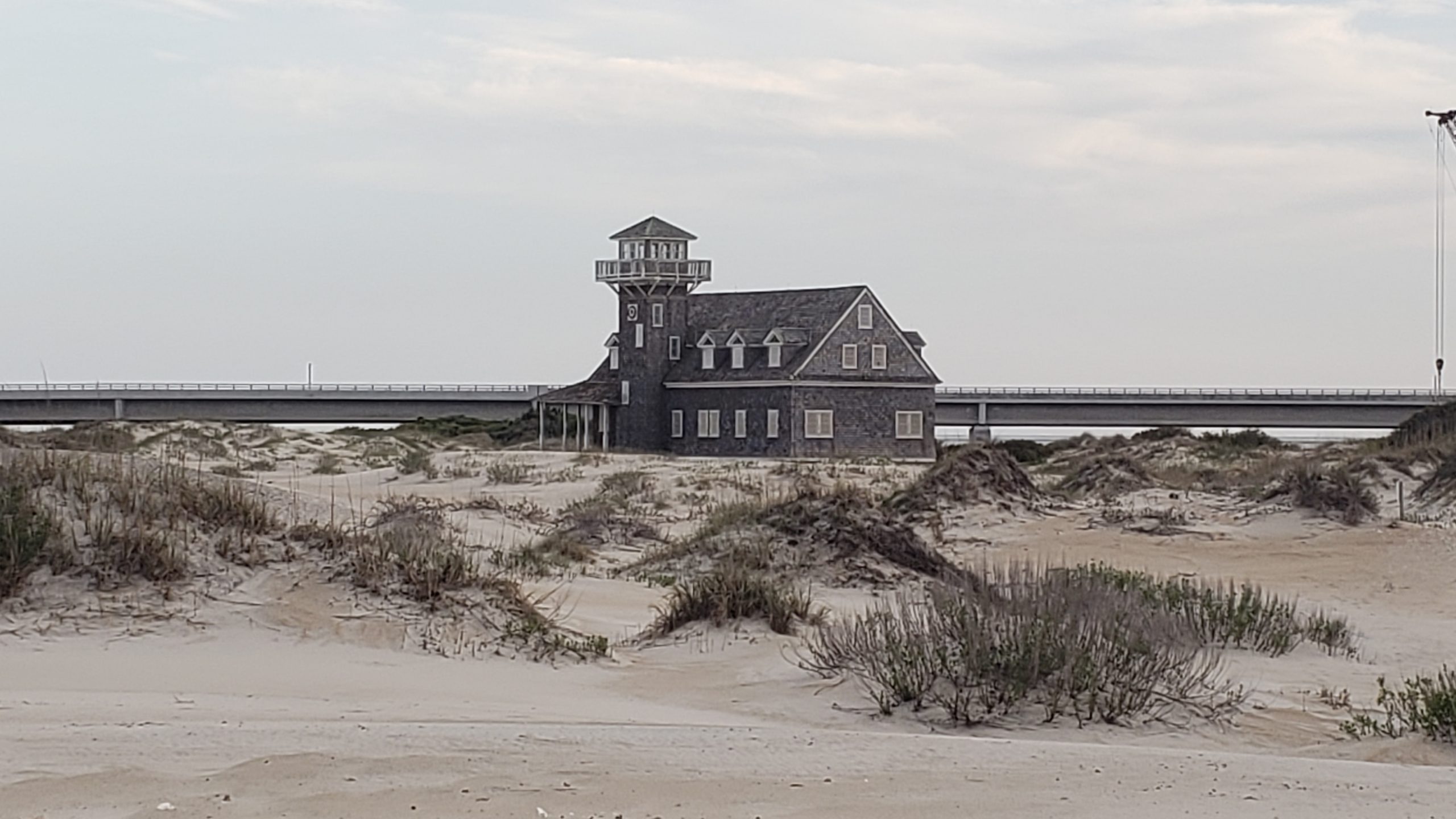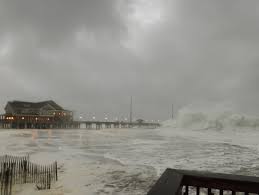
Chicamacomico Life-Saving Station is to be commended for celebrating the 150th anniversary of the first seven Outer Banks 1874 stations and the fine articles by Jen Carlson.
The Oregon Inlet Life-Saving Station was one of those first seven. Interestingly, the “Old” Oregon Inlet Life-Saving Station is the first one seen sitting majestically and solitarily on Hatteras Island at the landing off the artistic Marc Basnight Bridge, over the Oregon Inlet itself.
The Confusion Begins Immediately
However, this station is not the 1874 Station. The history and status of the Oregon Inlet Life-Saving Station has been shrouded in confusion and misconceptions from 1874 until today. It even started that way.

The Old Oregon Inlet Station has a funny, albeit somewhat confusing, history. It was one of the first seven stations in N.C., all built in 1874, but it was mistakenly named the “Bodie Island Station,” even though it was located on Pea Island, across the Oregon Inlet on the south, or Hatteras Island, side.
There is no official explanation for the confusion.
Later, in 1878, a new series of construction began, adding eleven more United States Life-Saving Service stations to the North Carolina coast. One of those was a new station built on Bodie Island near the present lighthouse, but it was named “Tommy’s Hummock.”
Finally, someone realized the naming mistake and renamed Tommy’s Hummock as the Bodie Island Station. So, the old Bodie Island station was renamed Oregon Inlet. It also had several replacement stations over the years, and the existing building is the 1898 station. When the new (current) Coast Guard station was built on the north side of Oregon Inlet, the older remaining one was commonly called the Old Oregon Inlet Station. The confusion is understandable.
The Second Level of Confusion
The old Oregon Inlet Life-Saving Station is often confused with the historic Pea Island Station, and this is an extremely common – and highly understandable – mistake.

The station today is the (Old) 1898 Oregon Inlet Life-Saving Station. Since it is located on the northern tip of Pea Island, it is natural to assume that it would be the famous Pea Island station. But Pea Island had two United States Life-Saving Service stations: 1874 Oregon Inlet on the north end and the Pea Island station on the south end.
This confusion is compounded by three things: The somewhat recent exterior renovations make it an extremely handsome and eye-catching structure, its isolation makes it quite conspicuous and readily seen from the south end of the Marc Basnight Bridge, and the road signs identify this area as the “Pea Island National Wildlife Refuge.”
To see how often this is mislabeled, do a web search for Pea Island Life-Saving Station and click on “images.” Almost every image, from all those different sources, is a photo of the Old Oregon Inlet station!
For clarity, there was a Pea Island station, but it was located approximately four miles farther in the area of the current Capt. Richard Etheridge Bridge. The original 1878 station was destroyed by fire. The replacement 1881 station was eventually also destroyed. The final 1931 station was decommissioned in 1947, was vacant for a while, and is now the Hatteras Watersports in Salvo.
The Current Confusion
It started in 1988 when the station was decommissioned, making way for the present U.S. Coast Guard Motor Lifeboat (USCG MLB) Station Oregon Inlet. As Standard Operating Procedure, the Coast Guard returned the property to the heirs of the original owners, which then owed property taxes to the state. Apparently, this was taking too long. The state had only one option and a lawsuit over ownership awarded the abandoned station to the State of North Carolina. The state really didn’t know what to do with it, so it offered it to the NC Aquarium on Roanoke Island (Manteo).
The Aquarium had big plans for it, and accomplished several designs and set a budget. Then, ironically, after a hurricane destroyed the wooden Jennette’s pier, the new, concrete, modern Jennette’s Pier was built instead. That is where all the state money and plans went, and it left the 1898 Life-Saving station with no future.

So, unfortunately, it remained abandoned, isolated, and vandalized. One major effort was made to address the situation and it was raised by quite a few feet. New siding and windows were also added, but the interior was stripped. However, it still remained abandoned, not maintained, and more vandalism occurred. I personally witnessed the station’s antique huge wooden cisterns being removed. This was over a period of time in broad daylight, so I thought it was maintenance. Turns out they were being boldly stolen!
To address the situation, the Aquarium now only had two realistic options: (1) give it away, or (2) move it to Manteo where they could at least save it from further deterioration and vandalism. The latter requires an expensive move, cutting the building and destroying a major part of Hatteras Island’s history.
Unfortunately, that spawned numerous inaccurate rumors for which the Outer Banks is famous, including the rumor that the structure had to be moved, but this is not the case. It could be resurrected by a nonprofit right where it is, and serve many useful functions and benefit hundreds of thousands of tourists. The most common argument against that is “a hurricane will soon get it if it stays there.” Well, it had been there since 1898… since 1898! It has seen quite a few storms in all those years.
Rescue is at Hand!
When I heard that the Aquarium still planned to remove this station from its historic birthplace of Hatteras Island, I was upset. Like many Hatteras Island residents, we heard for years that “somebody should do something to save our history.” So, in January of 2024, I formed the new 501 (c) (3) nonprofit organization the Outer Banks Coast Guard History Preservation Group. TM The broad name is to match its broad objective: starting with trying to rescue the 1898 Oregon Inlet U.S. Life-Saving Service Station No. 16. Then, to rescue, restore, assist, and promote all other Coast Guard related OBX organizations such as the 1874 Little Kinnakeet Life-Saving Station, the 1878 Bodie Island LSS, and the rest of the 88 Coast Guard-related North Carolina sites and entities which I have identified.
There are a lot of ducks to put in a row with a monumental project such as this, so it takes time, but remarkable progress has already been made. I have shared my detailed “4R’s” plan publicly by way of multiple press releases: Rescue-Restore-Rejuvenate-Repurpose.
With a Visitors Welcome Center, Life-Saving Station Museum, a large event venue, and soo much more, it could not only serve millions of people, but add to the economy of Hatteras Island, Dare County and the state of North Carolina. We have received great public support already.

We have a Board of Directors, have created a series of helping committees, are assembling a Board of Advisors, and have started fundraising efforts to create a “Starter Fund” for the upcoming major expenses. If you would like to be part of this heroic effort, contact me via the info below.
There will be a lot of expensive work to be done, so we are seeking donations from concerned citizens and visitors as well as major corporate sponsorships. If you can help in either area, please contact us at LifeSavingServiceOBX@gmail.com or by visiting www.OBXcoastguardHPG.com.
MISSION STATEMENT
Its name is the Outer Banks Coast Guard History Preservation GroupTM. The broad name is to match its broad objective: starting with rescuing the 1898 Oregon Inlet U.S. Life-Saving Service Station No. 16. Then, to rescue, restore, assist, promote all other Coast Guard related OBX organizations, of which there are quite a few.



